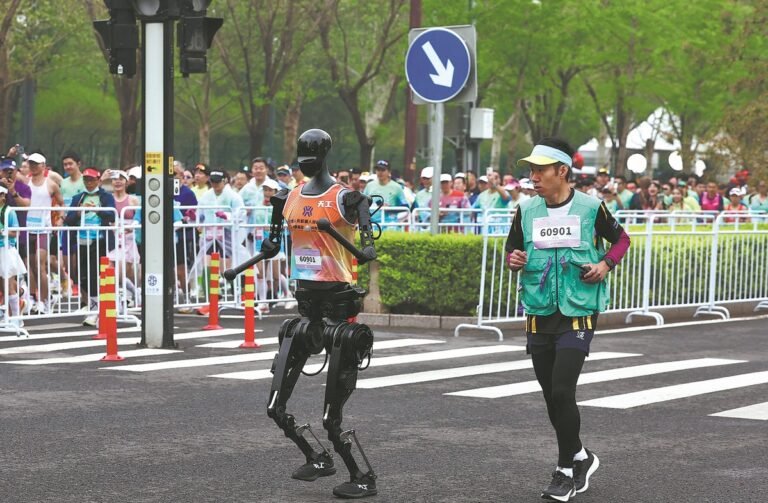Beijing has made history by hosting the world’s first half-marathon for humanoid robots. The unique event took place alongside a regular human marathon and featured 20 robot teams from Chinese universities, tech firms, and research labs. While the race showed off major progress in robotics, experts say there are still big challenges ahead before these machines can join our everyday lives.
Robots Run 21 Kilometers With Humans in Beijing
The event happened in the Beijing Economic-Technological Development Area, a key hub for China’s tech growth. It was organized to test how robots handle real-world conditions beyond the lab. Some of the robots were small and agile, like the 82-centimeter “Xiaohai,” while others were large and powerful, like the 1.8-meter-tall “Tiangong Ultra.”
Six out of the 20 robot teams finished the 21-kilometer race. Tiangong Ultra won the humanoid category with a time of 2 hours, 40 minutes, and 42 seconds.
Liang Liang, deputy director of the event’s organizing committee, explained why the marathon was important. In past tests, humanoid robots moved only in controlled lab setups. This race forced them to adapt to outdoor conditions like changing light, rough ground, and crowds. It was a “stress test” for robot performance in complex situations.
Why This Matters for the Future of Robots
Humanoid robots are no longer just science fiction. In China, they are starting to enter factories, schools, research centers, and other industries. One major example is a robot used for powerline inspections. Built by China Southern Power Grid, this robot works in remote areas with extreme weather—from minus 40 to plus 80 degrees Celsius. It already helps detect faults in hard-to-reach mountain zones.
Experts see robot marathons as more than just fun. These tests help developers see what needs to improve before humanoid robots can handle tasks like home care, public safety, or advanced manufacturing.
Investment in Robot Technology Is Growing Fast
Money is pouring into China’s robot industry. According to itjuzi.com, over 50 companies in the embodied AI sector raised more than 6 billion yuan ($970 million) in just the first three months of this year.
Many of China’s top tech firms and car makers have jumped into the race. Companies like GAC, SAIC, XPeng, Chery, Xiaomi, and suppliers like Huawei, Horizon Robotics, and Hesai Technology are all working on humanoid robots.
Outside China, six major car makers—Tesla, BMW, Mercedes-Benz, Honda, Toyota, and Hyundai—have also revealed their plans for humanoid robots. These companies see robots as a key part of their future.
From Level 2 to Level 4 Autonomy: The Road Is Long
Despite the excitement, experts say the tech is still in its early stages. Right now, most humanoid robots only have Level 2 autonomy, which means they need lots of human help. The goal is to reach Level 4 autonomy, where robots can make their own decisions and act safely in most situations.
He Xiaopeng, CEO of XPeng Motors, recently spoke with Wang Xingxing of Unitree Robotics and Zhou Jian of UBTech Robotics. They agreed that the jump from Level 2 to Level 3 will take a lot more work. Reaching Level 4 will take even longer.
Compared to self-driving cars, humanoid robots face harder problems. They must walk, balance, and react to the world around them. This includes stairs, uneven ground, and people moving in all directions. Their “brains” must handle sight, hearing, and decision-making in real-time.
Language Models Like DeepSeek Offer Hope
One bright spot is the rise of large language models (LLMs) like DeepSeek. These AI systems are helping robots improve how they think, learn, and act. LLMs can support robots in making better decisions, understanding their environment, and learning from new experiences.
According to the U.S.-based International Data Corp, LLMs could be the key to building the “brains” of next-generation humanoid robots. They can help robots talk, learn from feedback, and move more naturally through the world.
Looking Ahead: Robots Are Coming, But Slowly
For now, humanoid robots are not ready for home use. But events like the Beijing robot marathon are major steps forward. They show that robots can start to handle long-distance movement and complex tasks.
With more investment, stronger AI, and smarter designs, China and other countries are getting closer to a future where robots might help at home, work in dangerous places, or assist in hospitals.







